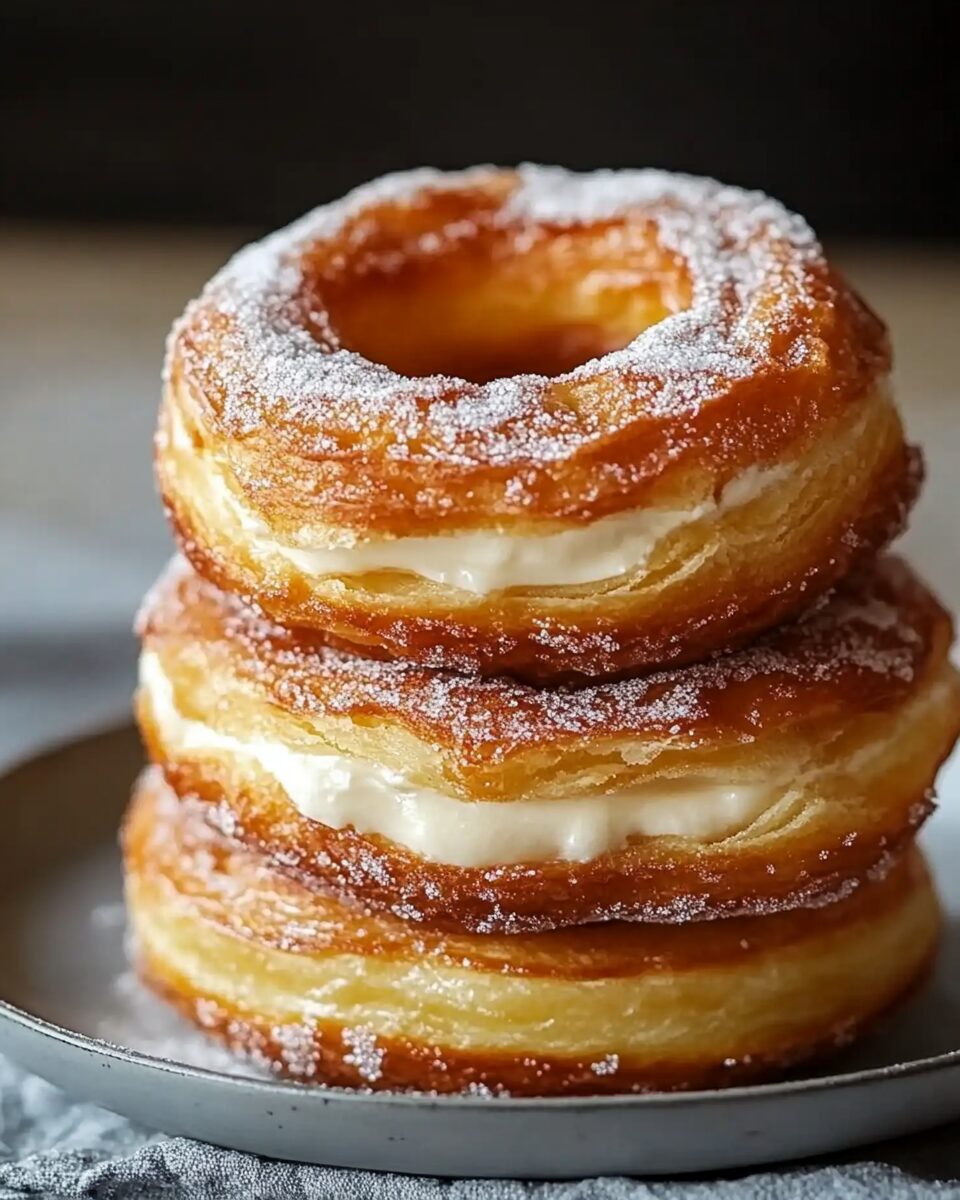These Homemade Cronuts combine the buttery, flaky layers of a croissant with the indulgent sweetness and shape of a doughnut. Deep-fried to golden perfection, rolled in sugar, and filled with luscious pastry cream, these pastries offer an unforgettable texture and flavor. While traditionally time-consuming, this streamlined version is ready in under two hours—making it perfect for special occasions, holiday brunches, or wow-worthy treats.
Full Recipe:
Ingredients
For the Dough:
-
2 cups all-purpose flour
-
¼ cup granulated sugar
-
1 tsp salt
-
½ cup unsalted butter, cold and cubed
-
½ cup warm milk
-
2¼ tsp active dry yeast (1 packet)
-
1 egg
-
1 tsp vanilla extract
For Frying & Finishing:
-
2 cups vegetable oil (for frying)
-
½ cup granulated sugar (for coating)
-
1 cup pastry cream or whipped cream (for filling)
-
1 tbsp vanilla extract (for pastry cream, optional)
Directions
1. Activate Yeast:
-
Dissolve yeast in warm milk. Let sit 5 minutes until foamy.
2. Make the Dough Base:
-
In a large bowl, mix flour, sugar, and salt.
-
Cut in cold butter until mixture is crumbly.
3. Add Wet Ingredients:
-
Mix in the yeast mixture, egg, and vanilla.
-
Knead for 5–7 minutes until dough is smooth.
4. Chill:
-
Wrap dough and refrigerate for 1 hour.
5. Roll & Fold:
-
Roll dough into a rectangle.
-
Fold into thirds like a letter. Repeat this process 3 times, chilling in between folds if needed.
6. Cut & Proof:
-
Roll dough to about ½ inch thick. Cut into doughnut shapes using a cutter.
-
Let rise for 30 minutes until slightly puffy.
7. Fry the Cronuts:
-
Heat oil to 350°F (175°C). Fry cronuts for 2–3 minutes per side, until golden brown.
-
Drain on paper towels.
8. Finish:
-
Roll in sugar while warm.
-
Once slightly cooled, fill with pastry cream using a piping bag.
Nutrients (Per Cronut – Estimated)
-
Calories: 380 kcal
-
Total Fat: 22 g
-
Carbohydrates: 45 g
-
Protein: 5 g
(Note: May vary based on filling and size.)
What Makes a Cronut So Special
A cronut combines two universally adored pastries—the croissant and the doughnut—into one jaw-dropping creation. From the croissant, it borrows delicate layers of dough laminated with butter, yielding a pastry that’s crisp on the outside and tender, flaky on the inside. From the doughnut, it takes its round shape, golden fried crust, and often a sweet filling or glaze.
The result is a textural masterpiece: rich, multi-dimensional, sweet yet sophisticated. It’s the kind of pastry that feels luxurious without being overly fussy. With every bite, you get the light crunch of fried dough, a sugary exterior, and creamy filling oozing from the center.
Simplifying the Process Without Sacrificing Flavor
Classic croissant dough takes three days of resting, folding, and chilling to perfect. This simplified cronut recipe offers an expedited version by blending the buttery method of lamination with a fast-rise dough. Instead of the full puff pastry technique, you get a quicker, easier dough that still produces tender layers and an airy rise.
Key steps like rolling and folding (repeated a few times) build in structure, while the single chill time keeps everything manageable. It’s an approachable technique that’s friendly even to those new to laminated doughs.
By frying the dough rather than baking, you also achieve instant puff and a golden-brown crust, mimicking bakery results without professional tools.
From Dough to Delight: How It All Comes Together
The cronut dough is made using a blend of all-purpose flour, sugar, salt, yeast, milk, and egg, enriched by cold butter, which is cut into the dough like in pie crust. This helps create those signature layers. After a short chill, the dough is rolled and folded several times in a letter-style fold—an essential trick borrowed from croissant making that traps pockets of air and butter to build flakiness.
Once shaped into rounds with a doughnut cutter and rested, the cronuts are fried until golden brown and puffed. While warm, they’re rolled in sugar, locking in that perfect sweet crunch. Once slightly cooled, they’re filled with your choice of pastry cream, whipped cream, or even jam using a piping bag, adding that signature touch of creamy indulgence to the flaky layers.
The Sweetest Finishing Touch: Sugar and Filling
While cronuts can be topped with glaze or icing, this version goes classic with a granulated sugar coating, which clings to the warm exterior for a glistening finish. It adds crunch and enhances every bite with subtle sweetness.
Inside, the pastry cream is where the fun begins. A silky custard enriched with egg yolks, milk, sugar, and vanilla, it offers contrast and richness that complements the crispy dough. You can customize this element based on occasion or mood:
-
Vanilla pastry cream – classic and elegant
-
Chocolate ganache – for deep, indulgent richness
-
Fruit jam or compote – for brightness and balance
-
Cinnamon whipped cream – for a light, spiced twist
Whatever you choose, the filling is what takes your cronuts from tasty to unforgettable.
Serving Ideas and Customizations
Homemade cronuts are incredibly versatile. You can enjoy them warm and fresh, dusted with sugar or glazed, filled or unfilled. Here are some ways to customize:
-
Holiday cronuts: Fill with pumpkin spice pastry cream or eggnog cream for seasonal flair.
-
Chocolate lovers: Drizzle with melted chocolate and top with crushed nuts.
-
Berry variation: Fill with raspberry or strawberry jam and finish with lemon glaze.
-
Tropical twist: Fill with coconut cream and top with toasted coconut flakes.
They also make fantastic party or brunch table centerpieces. Serve them on a tiered tray with multiple fillings and let guests pick their favorite flavors.
Storing and Reheating Tips
Cronuts are best enjoyed the day they’re made, especially when they’re still slightly warm and crispy. However, you can store leftovers in an airtight container at room temperature for up to 1 day. Because of their fried nature and cream filling, refrigeration can make them lose their texture and crispness.
To reheat:
-
Place unfilled cronuts in a 300°F (150°C) oven for 5–7 minutes to revive the exterior.
-
For filled cronuts, enjoy at room temperature to preserve the filling.
Avoid microwaving, as this can make them soggy.
If you’d like to prepare ahead, make the dough and store it chilled overnight before rolling and frying the next day. This gives even more flavor to the dough and allows for a make-ahead breakfast option.
Conclusion
Homemade Cronuts are a pastry lover’s dream: rich, flaky, sweet, and utterly satisfying. With this faster, simplified version, you don’t need to be a professional pastry chef or spend three days in the kitchen to enjoy their magic. Perfect for special mornings, celebratory brunches, or any moment where only the best will do, these cronuts offer a little luxury you can make from scratch. Once you’ve experienced their crisp exterior, melt-in-your-mouth interior, and creamy, sweet center, you’ll understand why the cronut phenomenon is still going strong—and why your own kitchen might just become the next hotspot for them.

